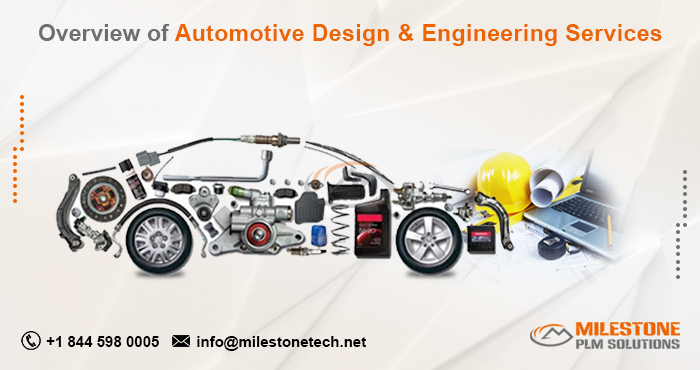An Overview of Automotive Design and Engineering Services

The automotive industry is a dynamic landscape, constantly pushing the boundaries of design, performance, and safety. Behind every sleek car and powerful engine lies a complex dance between creativity and technical expertise. This is where automotive design and engineering services come into play.
These services encompass a wide range of activities, from the initial spark of an idea to the final production of a vehicle. Let’s delve into the fascinating world of automotive design and engineering services and explore the key aspects that bring our dream cars to life:
Design: Where Form Meets Function
The journey begins with automotive design. This is where the artistic vision takes shape, blending aesthetics with functionality. Designers translate market trends, consumer preferences, and brand identity into captivating sketches and digital models.
Throughout the process, they consider various factors:
- Exterior Design: Creating a visually appealing and aerodynamically efficient body that is both stylish and functional.
- Interior Design: Crafting a comfortable, user-friendly, and aesthetically pleasing passenger experience.
- Human Factors Engineering: Ensuring ergonomics, ease of use, and safety for all occupants.
Engineering: The Science Behind the Style
Once the design is finalized, the baton passes to the automotive engineers. They transform the artistic vision into a tangible reality, ensuring the vehicle functions flawlessly and meets all safety and performance standards. Here’s a glimpse into some of their crucial tasks:
- Powertrain Engineering: Designing and developing efficient and powerful engines, transmissions, and drivetrains, considering factors like fuel efficiency and emissions.
- Vehicle Dynamics Engineering: Optimizing suspension, steering, and braking systems for superior handling, stability, and comfort.
- Safety Engineering: Implementing robust safety features like airbags, crumple zones, and advanced driver-assistance systems (ADAS) to ensure occupant protection.
- Materials Engineering: Selecting and integrating lightweight, durable, and sustainable materials for various vehicle components.
Prototyping: Bridging the Gap
The next step involves prototyping. This crucial stage allows engineers and designers to test the design and functionality of the vehicle in a physical form before mass production. Prototypes can be:
- Physical Prototypes: Functional models built using various materials to assess ergonomics, performance, and manufacturability.
- Virtual Prototypes: Utilizing computer-aided design (CAD) software and simulations to virtually test and refine the design.
Testing and Validation: Ensuring Quality and Safety
Once prototypes are built, rigorous testing and validation procedures come into play. Here, the vehicle is subjected to a battery of tests to ensure:
- Compliance with safety and regulatory standards
- Performance under various conditions (extreme temperatures, terrain, etc.)
- Durability and reliability of all components
- Fuel efficiency and emissions levels
Manufacturing and Production: From Prototype to Production Line
Following successful testing, the design and engineering specifications are translated into a manufacturing plan. This involves:
- Developing production processes and workflows
- Sourcing materials and components
- Setting up assembly lines and quality control measures
The Future of Automotive Design and Engineering Services
The automotive industry is undergoing a transformative shift, driven by advancements in electrification, autonomous driving, and connected car technologies. These trends are shaping the future of design and engineering services, demanding:
- Expertise in electric powertrains, battery management systems, and software development
- Focus on lightweight materials and sustainable manufacturing practices
- Integration of advanced driver-assistance systems (ADAS) and autonomous driving technologies
Conclusion
Automotive design and engineering services are the backbone of the automotive industry, playing a pivotal role in bringing innovative and exciting vehicles to the market. As technology continues to evolve, these services will play an even more crucial role in shaping the future of mobility, making transportation safer, cleaner, and more efficient.
Follow Milestone PLM Solutions for Mechanical Industry Updates, CAD Tips and Global Mechanical News.
Milestone PLM Solutions with its exclusive delivery center in India is a global CAD, CAM & FEA services outsourcing partner serving the needs of the Mechanical, Millwork and Automotive industry since 2004. MILESTONE focuses on the unique needs of clients and believe in tackling real-life problems with efficiency, smooth and ease.
The MILESTONE team can assist you with Product Design, 3d Modeling, Drafting & detailing, Reverse Engineering, FEA Analysis and more. We support multiple software including AutoCAD, Solidworks, Catia, NX, Inventor, Solidedge & Ansys etc. Our approach is to provide a dedicated team for each customer over ongoing project and deliver the quality output consistently.
With our state of art technology and large talent pool of Engineers, we are developing best in class solutions for our customers across the globe. We align with your culture and values to form unbreakable partnerships and are primed for success with over 100 employees and 150 customers in the US, Europe, India, and Asia.
You can email us at info@milestonetech.net and can log in to our website www. milestonetech.net to know more about our services and our work portfolio or contact us on +1-844-598-0005
